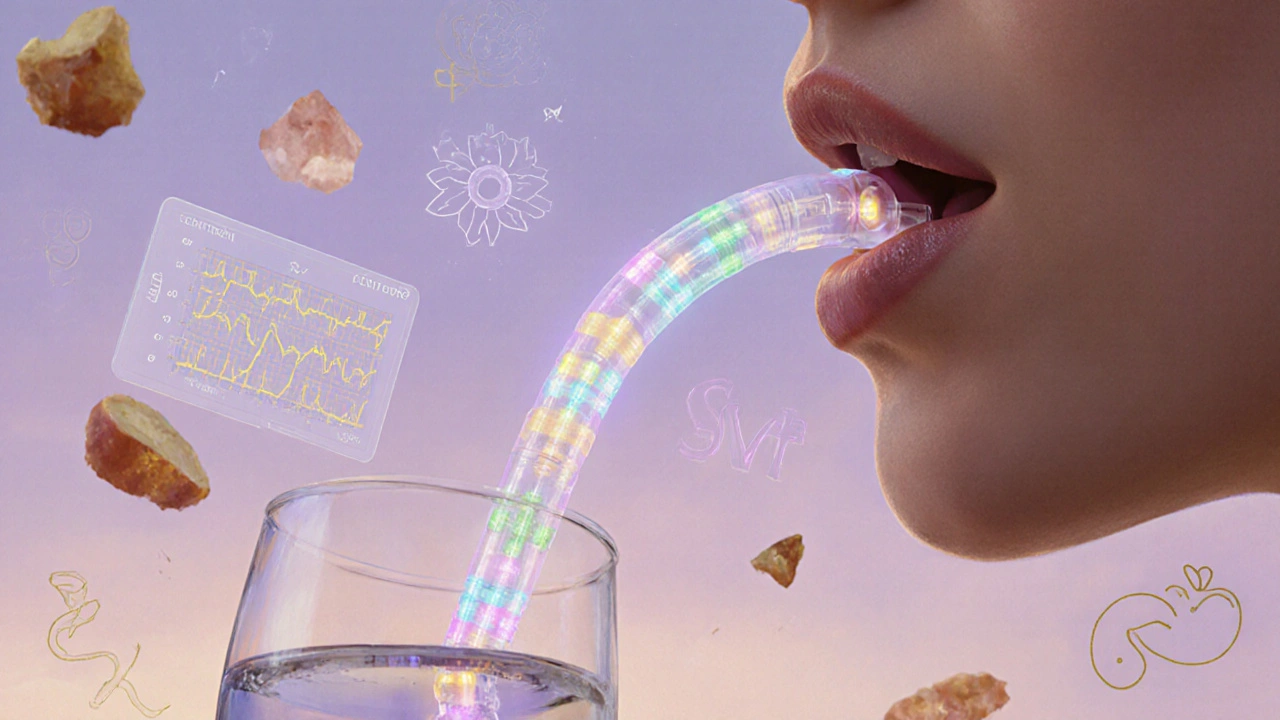Swallowing feels natural-until it doesn’t. If you’ve ever felt food stuck in your chest, had trouble getting liquids down, or experienced chest pain that mimics a heart attack, you might be dealing with an esophageal motility disorder. These aren’t rare quirks. They’re real, underdiagnosed conditions that mess with the muscles doing the hard work of moving food from your throat to your stomach. And the key to fixing them? A test called high-resolution manometry.
What’s Really Happening in Your Esophagus?
Your esophagus isn’t just a passive tube. It’s a muscular pipeline that contracts in a precise wave-called peristalsis-to push food downward. When those contractions are weak, uncoordinated, or too strong, food doesn’t move right. That’s when dysphagia (difficulty swallowing) shows up. But here’s the catch: dysphagia doesn’t always mean a blockage. Often, it’s a muscle problem. The most common motility disorders fall into two groups: primary (starting in the esophagus itself) and secondary (caused by something else, like scleroderma). Primary disorders include achalasia, diffuse esophageal spasm, nutcracker esophagus, and jackhammer esophagus. Each has a distinct pattern of muscle failure. Achalasia, for example, is when the lower esophageal sphincter (LES)-the valve at the bottom of the esophagus-won’t relax. Food piles up. The esophagus stretches. Over time, people lose weight, regurgitate undigested food, and feel chest pain. About 70% of achalasia cases are Type II, where the whole esophagus squeezes at once instead of moving food in waves. Type I is quieter-no contractions at all. Type III is chaotic, with violent spasms. Jackhammer esophagus is the opposite: contractions are too strong. Pressures can hit over 5,000 mmHg·s·cm (normal is under 1,000). People describe it as their chest being crushed. Nutcracker esophagus is similar but less extreme, with pressures over 180 mmHg. These aren’t just uncomfortable-they’re disabling. One patient told me, "I hadn’t eaten a sandwich in seven years. I was living on soup and smoothies."Why Manometry Is the Gold Standard
A barium swallow might show a dilated esophagus, but it won’t tell you why. Endoscopy rules out cancer or strictures, but it can’t see muscle function. That’s where high-resolution manometry (HRM) comes in. HRM uses a thin tube with 36 pressure sensors spaced just 1 cm apart. As you swallow water, it maps every contraction in real time. No guesswork. No blurry images. Just a detailed pressure topography that shows exactly where things go wrong. The Chicago Classification system-updated in 2023-is the rulebook doctors use to interpret these readings. Before HRM and this system, doctors disagreed on diagnoses up to half the time. Now, with standardized criteria, agreement jumps to 85%. That’s huge. HRM doesn’t just diagnose achalasia. It picks up esophagogastric junction outflow obstruction (EGJOO), a condition where the LES is stiff but still relaxes a little. It separates major disorders (that need treatment) from minor ones (that might be normal variants). This prevents overdiagnosis. As one expert put it: "We’ve stopped treating people who don’t need it."What the Test Feels Like (And Why It’s Worth It)
The procedure takes about 20 minutes. A thin catheter is passed through your nose into your esophagus. You’ll swallow sips of water. You might feel pressure, mild discomfort, or a gag reflex. About 35% of patients report discomfort, but few say it’s unbearable. The real issue isn’t the test-it’s the lack of awareness. Many patients see three or more doctors over 2-5 years before getting diagnosed. They’re told they have GERD and given proton pump inhibitors (PPIs). But if your problem is a muscle that won’t relax, PPIs won’t help. One patient spent eight years on acid blockers before HRM revealed jackhammer esophagus. Patient satisfaction soars when they understand what’s happening. One survey found 78% of people felt better after HRM, even before treatment-just because they finally had an answer. When doctors skip explaining the test, satisfaction drops to 45%.
What Happens After the Diagnosis?
Treatment depends on the disorder. For achalasia, there are three main options:- Laparoscopic Heller myotomy: A surgeon cuts the tight LES muscle through small belly incisions. It’s effective in 85-90% of cases at five years.
- Peroral endoscopic myotomy (POEM): A scope goes down your throat, and the muscle is cut from the inside. It’s equally effective but has higher reflux rates-44% at two years versus 29% with surgery.
- Pneumatic dilation: A balloon stretches the LES. Works in 70-80% of cases, but about a third need repeat procedures within five years.
Why This Matters Beyond the Clinic
Esophageal motility disorders are rising in diagnosis-not because they’re becoming more common, but because we’re finally looking the right way. In North America and Europe, 95% of academic centers have HRM. In community hospitals? Only 35%. In low-income countries? Less than 10%. The global market for diagnostic equipment is growing fast-projected to hit $410 million by 2028. But access isn’t equal. A single HRM system costs $50,000-$75,000. Training takes months. That’s why many patients in rural areas still wait years for answers. What’s clear is this: dysphagia isn’t just "getting older." It’s not just acid reflux. It’s a signal that your esophagus is struggling. And when you have the right test, the right diagnosis, and the right treatment, you can eat again. Not just soup. Not just purees. Real food.One man, after POEM, said: "I ate a burger last night. I cried. Not because it was spicy. Because I hadn’t had one since my 30s."

When to Ask for Manometry
You should consider high-resolution manometry if:- You have trouble swallowing solids, then liquids
- Food comes back up without nausea
- You have chest pain that doesn’t improve with heart meds
- PPIs haven’t helped your swallowing issues
- You’ve had normal endoscopy or barium swallow but still feel blocked
Is dysphagia always a sign of a serious condition?
Not always. Occasional trouble swallowing can happen after eating too fast or drinking something cold. But if it’s persistent, worsening, or happens with weight loss, regurgitation, or chest pain, it’s not normal. Esophageal motility disorders are serious but treatable. Ignoring them can lead to esophageal dilation, aspiration, or malnutrition.
Can I have an esophageal motility disorder without having achalasia?
Absolutely. Achalasia is just one type. Other disorders include diffuse esophageal spasm, nutcracker esophagus, jackhammer esophagus, and esophagogastric junction outflow obstruction (EGJOO). Each has different pressure patterns on manometry and requires different treatment. Many people are misdiagnosed with GERD when they actually have one of these.
Is high-resolution manometry painful?
It’s uncomfortable, not usually painful. A thin tube is passed through your nose into your esophagus. You’ll swallow water during the test. Most people feel pressure, a gag reflex, or mild sore throat afterward. About 35% report discomfort, but very few say it’s unbearable. The key is preparation: knowing what to expect makes it much easier.
Why do doctors order an endoscopy before manometry?
Endoscopy checks for structural problems-like strictures, tumors, or inflammation-that could be causing dysphagia. Manometry looks at muscle function. If you have a physical blockage, you need that treated first. Only after ruling out structural causes does it make sense to test for motility issues. It’s a stepwise approach: rule out the obvious, then dig deeper.
Can I get manometry done in a regular hospital?
It depends. High-resolution manometry requires specialized equipment and trained interpreters. In major academic centers and large cities, it’s widely available. In community hospitals or rural areas, it’s often not offered. If your doctor doesn’t have it, they can refer you to a motility center. Don’t assume you can’t get it-ask where the nearest specialized GI center is.
Are there alternatives to manometry?
Yes, but none are as accurate. Barium swallow shows shape and movement but misses subtle muscle patterns. Endoscopy sees the inside but not muscle contractions. Impedance planimetry (EndoFLIP) measures how stretchy the esophagus is and is useful for EGJOO. Wireless capsules like SmartPill can track motility over a day without a tube, but they’re not yet standard for diagnosing achalasia. HRM remains the gold standard.
How long does it take to get results from manometry?
The test itself takes 20 minutes. But interpreting the data takes time-often 30-60 minutes per study because patterns are complex. Results are usually available within 3-7 days. Some centers offer preliminary feedback right after the test, but the full report with classification (like Chicago v4.0) takes longer. Don’t rush the interpretation; accuracy matters more than speed.
Can esophageal motility disorders come back after treatment?
Yes, especially with pneumatic dilation-about 25-35% of people need repeat procedures within five years. POEM and Heller myotomy are more durable, but reflux can develop over time. Some patients need long-term medication or lifestyle changes. Regular follow-up is key. Even after successful treatment, symptoms can return if the underlying muscle dysfunction progresses or if new issues arise.
What Comes Next?
If you’ve been told your dysphagia is "just GERD" and nothing’s changed, ask for a referral to a motility specialist. Push for high-resolution manometry. Don’t settle for a label that doesn’t explain your symptoms. The technology exists. The expertise is growing. And the results-eating without fear-are life-changing.One thing’s certain: your esophagus doesn’t lie. When it struggles, the body screams. Manometry is the tool that finally lets us hear it.

